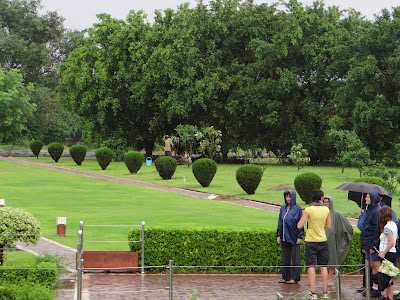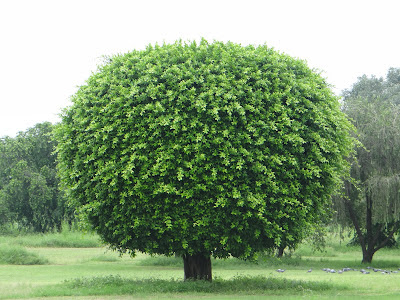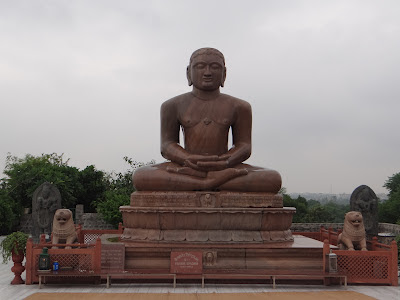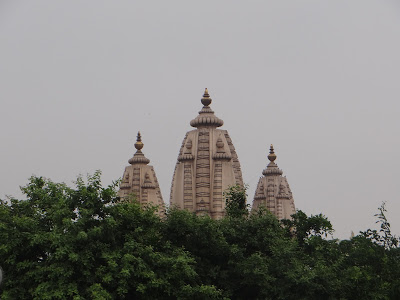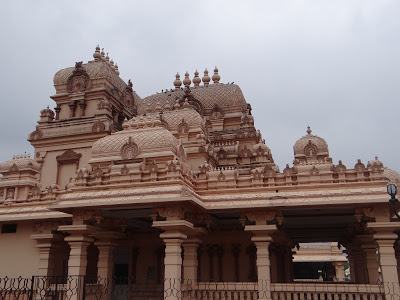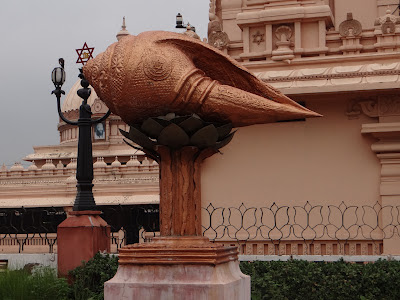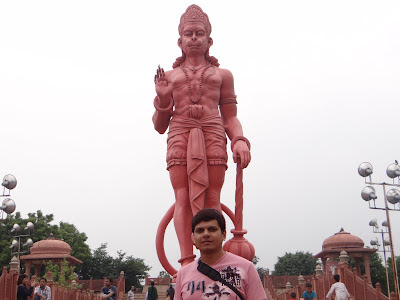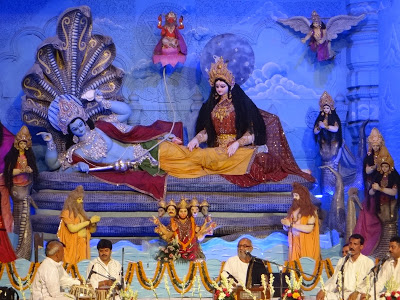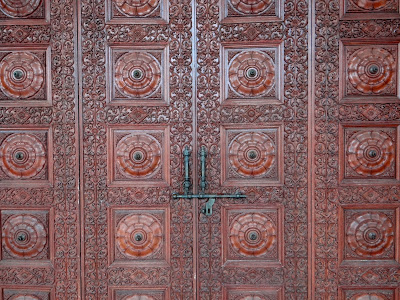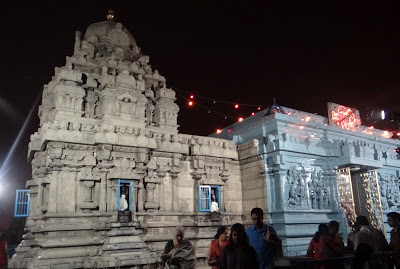The Bahaí House of Worship (Lotus Temple)
My temple trail has summoned me back seeking for more. It’s the month of August and monsoons have arrived in New Delhi. For days it has been raining cats and dogs. It is a welcome break after months of scorching summer heat. Torrential rains have descended upon us yet again since morning. While I wait inside my car for the rain to stop, I choose to click some interesting patterns of rain drops on the windscreen.
My first stop is the ‘Bahaí House of Worship’, commonly known as ‘Lotus Temple’. This magnificent structure is made in the shape of a lotus having 27 petals of white plaster covered with white Greek marble. Surrounding the temple are 9 pools of water, deep blue in colour to show as if the concrete flower is floating. The pools also play a significant role in the natural cooling system of the main prayer hall.
Lotus temple, although a place of worship for the Bahaí community, is flocked by people of all faiths as well as tourists all around the year. Lotus temple is one of the biggest structures of Bahai worship all over the world. The campus is spread across 26.6 acres of sprawling grasslands with beautiful trees and colourful budding flowers.
The most convenient way to reach is via The Delhi Metro. Get down at the ‘Nehru Place’ metro station and walk 200 mtrs. across the road. There is sufficient parking space available for private vehicles and tourist buses. The entry is free of cost with Monday being a day off for the temple.
I walk through the main gate to be welcomed by rows of trees on both the sides of the walkway and among them small lamps made of marble that lighten up the space at night. Up ahead of me are some Italian tourists clicking snaps and laughing away to glory.
I am in no hurry and take quite a long time to just stroll around in the vast space and enjoy the nature. The noise of honking vehicles and yelling hawkers outside is now fading. The magical silence of this paradise is taking over with occasional plops of raindrops falling on leaves and in puddles of water.
I leisurely walk through the grasslands and towards the main building which gets bigger as I get closer. Wearing shoes beyond a certain point is prohibited. I am happy to see that the tourists are very well managed by the volunteers and there is no pushing around. At the entrance of the prayer hall I am asked to stand in a queue and await a warm welcome by the volunteers followed by a two minute introduction to The Lotus Temple and Bahaí Faith.
We are welcomed in Hindi as well as English. I then move inside. In an instant, I experience silence like never before. Photography is prohibited inside because of the noise that a camera click makes. The silence is so deep, it is almost screaming at me. There are rows of wooden benches with marble surfaces to sit and pray on. At any given time 1300 people can sit inside this prayer hall. The floor is spiky clean and a bliss to walk on.
I hear an occasional squeal of a child which is amplified multiple times before it slowly fades off. In my experience, the sound of silence in this place also gets similarly amplified with each and every passing moment. I am just sitting, doing nothing but everything. With the external sounds being cut off, I begin to listen to the voices inside my head. I can visualize my thoughts and choose which ones I want to keep. I begin to experience the various sensations in my body, the vibration in my calf muscles and my heart beat. Slowly the space begins to take away my fatigue. I actually experience my muscles rejuvenating. I sit there for a whole hour. By the time I come out, I feel more vibrant, energetic and peaceful. Yes, ‘Energetic and Peaceful’, a combination rarely experienced in today’s lifestyle.

Outside the prayer hall, ‘Farida’ who is a volunteer from Iran tells me that Bahaí faith teaches equality of all religions. One of the prayers by ‘Bahaú’llah’ who is the founder of Bahaí faith is:
‘God grant that the light of unity may envelop the whole earth, and that the seal, “The Kingdom is God’s”, may be stamped upon the brow of all its peoples’. – Baha’u’llah
Farida further explains that Bahaí faith originated in ‘Persia’ (present day Iran). After the persecution of Bahaí people by Iran’s religious orthodoxy in the early 20th century, Bahaís migrated to various countries around the world. India has the largest population of approximately 2.9 million.
Presently, Bahai centres of worship exist in Israel, Western Samoa, Australia, Uganda, Panama, Germany and USA along with many other nations around the world.
It is time for me to move on to the next destination. I leave this place with another saying by Baha’u’llah in my mind:
‘It is not for him to pride himself who loveth his own country, but rather for him who loveth the whole world. The earth is but one country, and mankind its citizens’ – Baha’u’llah
Ahimsa Sthal (Place of Non-Violence)
My next destination ‘Ahimsa Sthal’ was not in my menu initially but on my way to the ‘Chhattarpur Temple’, I stopped at this small but very interesting place. ‘Ahimsa Sthal’, which literally translates to ‘A place of non-violence’, is a small Jain shrine perched on the top of a rocky hill near Mehrauli. Being a Jain shrine it is dedicated to ’Lord Mahavira’.
The best way to reach this place if you are not in your private vehicle is by The Delhi Metro once again. Nearest metro station is ‘Qutub Minar’. One needs to just get off the Metro and ask for directions. Do not hire an auto-rickshaw as this is at walking distance. Other attractions like Qutub Minar are also nearby and anyone can easily combine these two in a single visit. Ahimsa Sthal is open seven days a week.
I park my car outside and walk-in. Entry is free. Wearing shoes is prohibited and I have to deposit them in the room right next to the main gate. Although this place is smaller than the Lotus temple but it is equally well maintained. The gardens and walkways around are very well kept. I climb a flight of stone stairs to reach the main terrace where the 14 feet statue of ‘Lord Mahavira’ is perched.
Have you ever seen lush green plants and trees growing from the crevices in barren rock? I could see ample of them here. Some trees which probably germinated in the soil below these rocks have cracked the rocks apart. In Indian mythology it is believed that the aura, energy and purity of the space can make the place lush green and fertile. If the same aura is negative and disturbing it can convert a lush green land into a barren patch. There are such lush green places all over India, especially where mass meditation is practised. The landscape at these places is totally different from that of the surrounding areas. The land once barren starts to become fertile and green. Rain clouds show up and temperature becomes cooler. One needs to be in that space and experience it with time. One may even choose to participate in meditation to experience this change not only outside but within. It is not something to be logically understood and figured out in mind.

On the way down, there are numerous statues of ‘Apsaras’ like the one above scattered around. These small things make this place extremely peaceful, beautiful and a pleasure to visit not only once but regularly. I want to stay here longer, if only there weren’t other destinations on my list.
Chhattarpur Temple
My next destination is the ‘Chhattarpur Temple Complex’. Believe me, if only the cars on roads were replaced by horse drawn carriages and clothing of people changed to more traditional, this place would become a perfect ancient Kingdom in itself. It is no less than a kingdom even now. The complex comprises of 20 temples ranging from size small to massive. Spread across 60 acres of land, this is the second largest temple complex in Northern India after ‘Swaminarayan Akshardhaam’. The largest is ‘The Angkor Wat’ in Cambodia.
I am surprised why this place is not promoted as much as other places are and is not flocked by tourists from all over the world. I can see tourist buses only from nearby states. It is in the vicinity of ‘Qutub Minar’ and ‘Ahimsa Sthal’. Nearest Metro Station is ‘Chhattarpur’. Get down at the metro station and just walk. Entry to all the temples is free.
I park my car and take one of the first snaps of with the Chhattarpur temple looming high above my head and the trees. The ‘Jaali’ (Lattice) work in stone around temple balconies, although comparatively simple as compared to various other Lattice works across India, is very beautiful. The temples’ architecture is a mix of North and South Indian art.
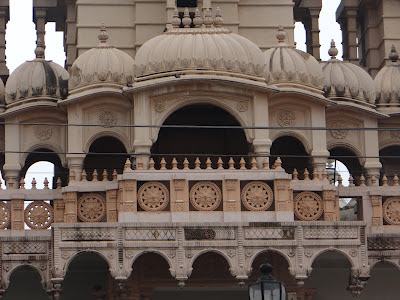
I take a deep breath as there is lot to see and start with the ‘Shiv Gauri Nageshwar Temple’. Right at the entrance is a huge ‘Trishul’ (Trident) covered with bronze snakes and ‘Damru’ (A small two headed drum). A trident, in Indian Hindu mythology, is considered as the main weapon of Lord Shiva. Trishul means ‘Three spears’ in ‘Sanskrit’ and ‘Pali’ (an Indian language older than Sanskrit). Notice the three points of the trident. There are numerous things that these represent. Most commonly, they are said to represent the three trinities – ‘Creation’, ‘Maintenance’ and ‘Destruction’. In terms of time, they represent ‘Past’, ‘Present’ and ‘Future’. And in terms of a human body, they represent the three main channels of energy i.e. ‘Ida’, ‘Pingala’ and ‘Sushmana’. The whole trident itself is mounted over a huge tortoise made of bronze. Everything around is so massive that it adds to the grandeur of this place. Right behind the Trident is a temple based on primarily South Indian architecture. This one is unfortunately locked at this point in time.

Since I can’t go in, I just decide to spend some time watching the fine art work over the temple’s walls. Right next to this temple, is a huge ‘Shankh’ (Conch shell).
Try holding a conch shell against your ear. You will hear the sound of the ocean humming gently. It is the natural vibration of cosmic energy of the earth that gets magnified on entering a conch shell. That is why a conch shell is often blown during any Hindu religious ceremony during sacred rites to get rid of negative energy in the space.
I have always seen conch shells being blown by priests in sacred rituals at home or in temples. I even feel mesmerized by their sound but I didn’t know their significance until I visited this place and did some research. I can feel the pangs upon thinking that if the sound of one conch shell has such power, what power would reside in the sound of a thousand blown together in synchronization. A scientist from India who has a collection of over a 1000 conch shells says that if they are all placed in a particular pattern and blown in sync, they will create energy powerful enough to gradually heal the ozone layer.
Up ahead is the ‘Sri Shiv Gauri Nageshwar Temple’. There are two huge elephants carved in black stone on each side of this temple’s main entrance. I suppose they represent actual elephants which were used in ancient as well as medieval times to welcome and honour guests. Even today, in lavish marriage ceremonies, elephants are used to welcome the guests. These elephants stand on each side of the entrance to the main hall and using their trunk throw flowers on guests.
This whole complex as I read on one of the placards was built by Honourable ’ Sri Sant Nagpalji’. Sri Shiv Gauri Nageshwar Temple is the place where he attained ‘Samadhi’ and became one with infinity in the year 1998. ‘Becoming one with infinity’ or Samadhi is when someone attains the final liberation after leaving his body at the time of death.
Right next this temple is a towering red statue of ‘Lord Hanuman’. I am quite tall but not taller than even the tow finger of this statue. The open space is very clean and the gentle breeze blowing around after a brief rain is very soothing. This statue is carved by a single artist whose name is carved on Lord Hanuman’s tail.
Next I walk across the street to the ‘Ram Temple’. At the entrance itself, I see a tree which seems to be of great significance. There are countless ‘Lal Chunni’ (pieces of red cloth like a stoll but smaller) tied to this tree. I ask the priest sitting nearby and he explains that people believe tying a Chunni to this tree brings good luck to them and fulfils their wishes. I do not have any wish that I desperately want fulfilled so I just watch this beautiful tree and move on.
Isn’t it amazing that in today’s world where people do not have faith in each other, the age old traditions and customs in India are still alive and thriving and people have unconditional faith in them? Although many people are not aware of the scientific significance of these rituals but if some research is done on them, the answers would be astounding.
I hear loud sound of music and move towards a huge hall filled with guests and some musicians singing devotional songs to ‘Lord Krishna’. Books, on what they are singing, are being distributed so that the spectators can follow each and every word. The main singer sitting in the middle is smiling all the time as he is singing. He seems to have totally given in to the pleasure of the moment.
In the same temple complex are two glass cased rooms meant to be the rooms of ‘Godess Katyani’. First is a dining room with a dining table and chairs with some fruits, water and glasses kept on the table. Second and the most beautiful one is ‘The Shayan Kaksha’ (Bed room) with a beautifully carved bed and a dressing table with all the make-up that the Goddess would need. The dressing table as I come to know is carved in silver. The royal appearance of rooms makes me ponder over the appearance of heaven.
Photography in this particular area and that of the idols is forbidden, so I decide to maintain the sanctity even though no one is policing around on the visitors.
Phew… !!! Next and the last temple is the ‘Laxmi Vinayak Temple’. This one is a true depiction of the South Indian architecture. My legs should be tired by now from walking around but I don’t feel anything. Probably their signals are not reaching my brain which is too excited. After walking around the entire day, I feel even more energetic.
The lamp posts on the pathway to this temple are beautiful. Each one of them is carved in a similar pattern. I wonder what this place looks like at night. The pathway is lined with couple of palm trees. There is small museum as well in this temple dedicated to ‘Sri Sant Nagpal Ji’. The entry is free. It has a huge statue of ’Sri Sant Nagpal Ji’ at the entrance. All the things he used right from his clothes, his bed, medical equipment he used to treat people and even his ‘Jataayen’ (Long hair tied together. Typically kept that way by the priests and ascetics in India) are displayed.
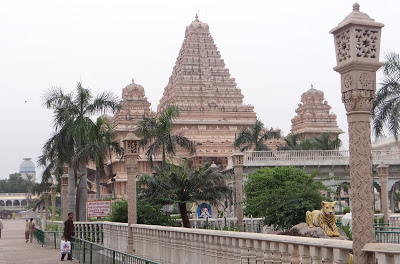
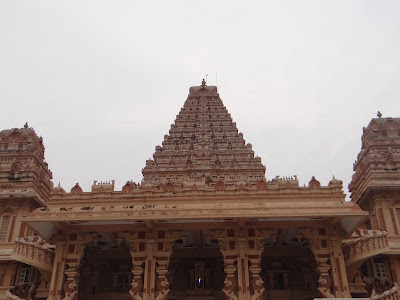
The temple has three wooden gates. The middle one is open for visitors and two side ones are closed. The carving on these huge doors is intricate. This place’s magnanimity is so graceful. It would have taken so many skilled craftsmen to carve these three huge doors. No one today knows who the artists were by name. Probably after centuries no one will even know who we were. Humans will come and will keep on becoming one with the infinite but their footprint left on this earth in the form of culture and such creations are timeless.
Uttara Swami Malai Temple
It’s dusk and light drizzle has started again. One more temple on which I have my eye on since months is ‘The Uttara Swami Malai Temple’ in R.K. Puram. This temple is dedicated to ‘Lord Swaminatha’ (more commonly known as ‘Lord Murugan’) and most revered by the religious Hindus in Delhi from the states of ‘Andhra Pradesh’, ‘Tamil Nadu’, ‘Karnataka’ and ‘Kerala’.
There are no metro stations around this temple, so the best way to travel here is by the Delhi Transport Corporation bus. It is closed to visitors during afternoon hours from 12 noon to 5 pm. A sign outside the temple is written in ‘Tamil’, proclaiming Lord Swaminatha’s motto ‘Yaamirukka Bayamain’ which translates to – ‘Why fear when I am there?’
To reach the main temple, I have to walk and climb stairs as it is perched on top of a hill. Men and women speaking Tamil can be heard all around. Tamil prayers are being recited by the priests. There are men dressed in white Veshtis and women in traditional Sarees and fragrant white flowers entwined in their hair. The black statue of ‘Goddess Meenakshi Devi’ is always dressed in bright ‘Kanjeevaram Sarees’.
I am lucky to reach here at 7 pm. People from local south Indian community are gathered in the main shrine with baskets containing flowers and banana. The priests are reciting synchronized prayers in Tamil. Curtains are drawn and we have to wait till the hymns are complete. The moment the hymns are complete and curtains are opened, people fold their hands and raise them high in the air to seek the Goddesses’ blessings.
This is a small temple but worth a visit in one of the evenings. After the small ceremony is over, I stroll around the small patio on top of the hill watching lights of rows of traffic on the road below.
This temple trail has led me to explore the secrets of my own culture which were previously unknown to me. I now know that traditions practised for centuries in India are not just some Mumbo-Jumbo but very scientific in nature. Only if people are aware of them, they have power to do miracles. Conch shells having the power to heal the ozone layer is no less than a miracle. And what is even more astonishing is that they were practised centuries before modern science came into existence and still are.


